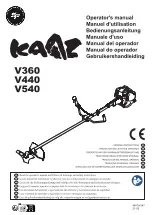
GB-7
G
B
WARNING!
A cutting attachment can injure while it continues to spin after
the engine is stopped or power control is released.
When the unit is turned off, make sure the cutting attachment
has stopped before the unit is set down.
Maintenance
MAINTENANCE, REPLACEMENT, OR REPAIR OF THE
EMISSION CONTROL DEVICES AND SYSTEMS MAY
BE PERFORMED BY ANY NON-ROAD ENGINE REPAIR
ESTABLISHMENT OR INDIVIDUAL.
Carburetor adjustment (Fig. 27)
WARNING!
The cutting attachment may be spinning during carburetor
adjustments.
WARNING!
Never start the engine without the complete clutch cover and
tube assembled! Otherwise the clutch can come loose and
cause personal injuries.
In the carburetor, fuel is mixed with air. When the engine is test
run at the factory, the carburetor is basically adjusted. A further
adjustment may be required, according to climate and altitude. The
carburetor has one adjustment possibility:
T = Idle speed adjustment screw.
Idle speed adjustment (T)
Check that the air filter is clean. When the idle speed is correct, the
cutting attachment will not rotate. If adjustment is required, close
(clock-wise) the T-screw, with the engine running, until the cutting
attachment starts to rotate. Open (counter-clockwise) the screw
until the cutting attachment stops. You have reached the correct
idle speed when the engine runs smoothly in all positions well
below the rpm when the cutting attachment starts to rotate.
If the cutting attachment still rotates after idle speed adjustment,
contact HITACHI Authorized Service Centers.
NOTE!
Standard Idle rpm is 2,800~3,200 min
-1
.
NOTE!
Some models sold areas with strict exhaust emission regulation
do not have high and low speed carburetor adjustments. Such
adjustments may allow the engine to be operated outside of their
emission compliance limits. For these models, the only carburetor
adjustment is idle speed.
For models that equipped with low and high speed adjustments;
carburetors are pre set at the factory Minor adjustments may
optimize performance based on climate, altitude, etc. Never turn
the adjustment screws in increments greater than 90 degrees, as
engine damage can result from incorrect adjustment If you are not
familiar with type of adjustment-assistance HITACHI Authorized
Service Centers.
WARNING!
When the engine is idling the cutting attachment must under
no circumstances rotate.
Air filter (Fig. 28)
The air filter must be cleaned from dust and dirt in order to avoid:
• Carburetor malfunctions.
• Starting problems.
• Engine power reduction.
• Unnecessary wear on the engine parts.
• Abnormal fuel consumption.
Clean the air filter daily or more often if working in exceptionally
dusty areas.
Cleaning the air filter
Remove the air filter cover and the filter (1). Rinse it in warm soap
suds. Check that the filter is dry before reassembly. An air filter
that has been used for some time cannot be cleaned completely.
Therefore, it must regularly be replaced with a new one. A damaged
filter must always be replaced.
Fuel filter (Fig. 29)
Drain all fuel from fuel tank and pull fuel filter line from tank. Pull
filter element out of holder assembly and rinse element in warm
water with detergent.
Rinse thoroughly until all traces of detergent are eliminated.
Squeeze, do not wring, away excess water and allow element to air
dry.
NOTE!
If element is hard due to excessive dirt buildup, replace it.
Spark plug (Fig. 30)
The spark plug condition is influenced by:
• An incorrect carburetor setting.
• Wrong fuel mixture (too much oil in the gasoline)
• A dirty air filter.
• Hard running conditions (such as cold weather).
These factors cause deposits on the spark plug electrodes, which
may result in malfunction and starting difficulties. If the engine
is low on power, difficult to start or runs poorly at idling speed,
always check the spark plug first. If the spark plug is dirty, clean it
and check the electrode gap. Re-adjust if necessary. The correct
gap is 0.6 mm. The spark plug should be replaced after about 100
operation hours or earlier if the electrodes are badly eroded.
NOTE!
In some areas, local law requires using a resistor spark plug to
suppress ignition signals. If this machine was originally equipped
with resistor spark plug, use same type of spark plug for
replacement.
Angle transmission (Fig. 31)
Содержание CG28EJ
Страница 2: ......
Страница 3: ...1 3 2 1 3 2 1 1 3 2 ...
Страница 4: ...5 5 1 2 3 4 2 1 3 4 CH 100 17cm 17cm 1 2 3 ...
Страница 5: ...5 4 15m 1 2 3 ...
Страница 6: ...1 2 R1 1 5 mm 1 9 2 2 mm ...
Страница 24: ...GR 2 ƨƼ ƸƼƿƴƼ DžƼ A 4 2 B C D 4 E F 4 G H I A B C J D E F K 10 10 10 ...
Страница 87: ...MEMO ...














































